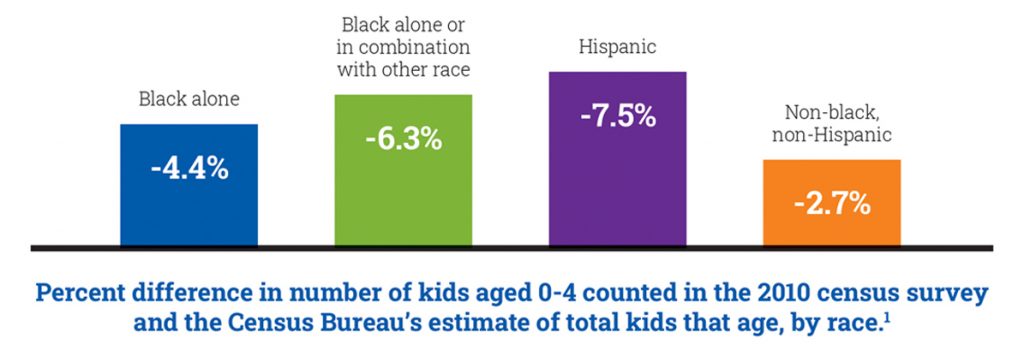The 2020 Census is underway and it’s critical that we count every child. When we miss young children in the census, it has serious consequences for them, their families, their communities and our nation –with many of those consequences lasting for at least 10 years; most of their childhood.
Who is at risk of being missed?
Children of color have been historically undercounted by the census. Not only are people of color consistently undercounted, but non-Hispanic whites have been consistently over counted, further compounding the problem. The rate of uncounted young kids in urban areas is double or triple the national figure, and that kids of color are also more likely to be missed.1
Why does it happen?
Many communities of color have endured a long history of inequitable treatment from governmental authorities resulting in significant distrust that has adversely impacted participation in the Census.
There are also factors specific to various communities of color that further contribute to their historical undercounting:
- African Americans are statistically less likely to have internet access at home, an increasingly important factor as much of the Census moves online;
- Latinos are more likely to be immigrants and therefore non-English speakers; and
- some Asian immigrants come from countries that do not have a census system.
Undercounting has been a consistent issue for many communities of color, including African Americans, Latinos, Asians and Pacific Islanders, and Indigenous Peoples.
Why does it matter?
For each child not counted in Pennsylvania, we lost $1,746 in federal funding for Medicaid, CHIP, Foster Care, Adoption, and Child Care. In the last census, PA undercounted 25,197 kids, resulting in nearly $44 million in lost federal funding.
States use census data to redraw federal, state, local and school voting districts. As well as allocate over $800 billion a year in federal funds for programs such as:
- health insurance programs like Medicaid and the Children’s Health Insurance program;
- education programs like Title I funding to schools in lowincome communities and IDEA special education funding for children with disabilities;
- programs that keep children safe, like foster care; and
- programs that help children learn while their parents work, by helping pay for quality child care.
If there is a child living in your home on April 1, 2020, that kid counts!
Visit CountAllKids.org for more information.
Sources:
1William O’Hare, demographer: https://fivethirtyeight.com/features/a-million-children-didnt-show-upin-the-2010-census-how-many-will-be-missing-in-2020/
2 Census Bureau’s Hard to Count Population Working Group

